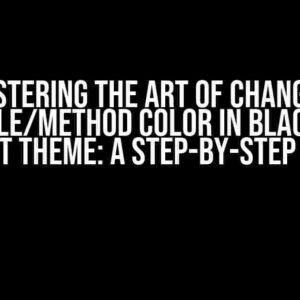Are you ready to take your web development skills to the next level? Look no further! NextJs 14 has arrived, and with it, the exciting world of Server Components and Browser Navigation. In this comprehensive guide, we’ll dive into the benefits, architecture, and implementation of this revolutionary technology.
What are Server Components?
Server Components are a new type of component in NextJs 14 that allows you to run React components on the server. Yes, you read that right – on the server! This means you can leverage the power of server-side rendering (SSR) without the need for a separate API or backend service. With Server Components, you can create dynamic, data-driven pages that are fast, secure, and scalable.
Benefits of Server Components
- Faster Page Loads: Server Components enable server-side rendering, which means that the initial page load is faster and more efficient.
- Improved SEO: Search engines can crawl and index your server-rendered pages, improving your website’s visibility and ranking.
- Enhanced Security: Server Components allow you to protect sensitive data and logic on the server, reducing the risk of client-side attacks.
- Simplified Development: With Server Components, you can write server-side code using React, eliminating the need for a separate API or backend service.
Introduction to Browser Navigation
Browse Navigation is a new feature in NextJs 14 that allows you to navigate between pages using the browser’s native navigation API. This means that you can create a seamless, native-like navigation experience for your users, without the need for client-side routing or JavaScript redirects.
Benefits of Browser Navigation
- Faster Navigation: Browser Navigation uses the browser’s native navigation API, which means that page transitions are faster and more efficient.
- Improved Accessibility: Browser Navigation provides a native-like navigation experience, making it easier for users with disabilities to navigate your website.
- Simplified Development: With Browser Navigation, you can focus on building your application’s logic and UI, without worrying about client-side routing or JavaScript redirects.
Implementing Server Components with Browser Navigation
Now that we’ve covered the basics, let’s dive into the implementation details. In this section, we’ll create a simple NextJs 14 project that demonstrates the power of Server Components and Browser Navigation.
Step 1: Create a New NextJs 14 Project
npm init next-app my-appStep 2: Create a Server Component
In your `pages` directory, create a new file called `hello.js` with the following code:
import { Fragment } from 'react';
const Hello = () => {
return (
<Fragment>
<h1>Hello, World!</h1>
<p>This is a server-rendered page</p>
</Fragment>
);
};
export default Hello;
Step 3: Configure Browser Navigation
In your `next.config.js` file, add the following configuration:
module.exports = {
//...
experimental: {
browserNavigation: true,
},
};Step 4: Create a Browser-Navigable Page
In your `pages` directory, create a new file called `about.js` with the following code:
import Link from 'next/link';
const About = () => {
return (
<div>
<h1>About Us</h1>
<p>This is a browser-navigable page</p>
<Link href="/"><a>Back to Home</a></Link>
</div>
);
};Step 5: Run the Application
npm run devOpen your browser and navigate to `http://localhost:3000`. You should see the `Hello` page rendered on the server. Click on the `About` link to navigate to the `About` page, which will be rendered on the client.
Common Use Cases for Server Components with Browser Navigation
Now that we’ve demonstrated the power of Server Components and Browser Navigation, let’s explore some common use cases for this technology:
| Use Case | Description |
|---|---|
| E-commerce Website | Use Server Components to render product pages on the server, and Browser Navigation to provide a seamless shopping experience. |
| Blog or News Website | Use Server Components to render article pages on the server, and Browser Navigation to provide fast and efficient navigation between articles. |
| Authentication and Authorization | Use Server Components to handle authentication and authorization logic on the server, and Browser Navigation to provide a secure and seamless login experience. |
Conclusion
In this comprehensive guide, we’ve covered the basics of Server Components and Browser Navigation in NextJs 14. We’ve demonstrated how to implement this technology in a real-world project, and explored common use cases for this powerful feature.
With Server Components and Browser Navigation, you can create fast, secure, and scalable web applications that provide a native-like navigation experience for your users. Whether you’re building an e-commerce website, a blog, or an authentication system, this technology has the potential to revolutionize the way you approach web development.
So what are you waiting for? Dive into the world of NextJs 14 and start building your next-generation web application today!
Here are 5 Questions and Answers about “NextJs 14 Server Components with Browser Navigation” in a creative voice and tone:
Frequently Asked Question
Welcome to our FAQ section, where we demystify NextJs 14 Server Components with Browser Navigation!
What are Server Components in NextJs 14?
Server Components are a new feature in NextJs 14 that allows you to render components on the server-side, giving you the benefits of server-side rendering (SSR) without the need for a full page reload. This means faster page loads, better SEO, and a more seamless user experience!
How do Browser Navigation and Server Components work together in NextJs 14?
When you navigate to a new page, NextJs 14 uses the browser’s native navigation API to send a request to the server, which then renders the new page using Server Components. The server returns the rendered HTML, which is then hydrated on the client-side, allowing for fast and seamless navigation between pages. It’s like having your cake and eating it too!
Do I need to rewrite my entire app to use Server Components in NextJs 14?
The good news is that you don’t need to rewrite your entire app to take advantage of Server Components. You can incrementally adopt Server Components for specific pages or routes, allowing you to gradually modernize your app and reap the benefits of improved performance and SEO.
Are Server Components in NextJs 14 compatible with client-side rendering (CSR)?
Absolutely! Server Components work seamlessly with client-side rendering (CSR). In fact, NextJs 14 allows you to use a hybrid approach, where some components are rendered on the server-side, while others are rendered on the client-side. This gives you the flexibility to choose the best rendering strategy for each component, depending on your app’s specific needs.
How do I get started with Server Components in NextJs 14?
Getting started with Server Components is easier than you think! First, make sure you’re running NextJs 14. Then, create a new page or route and wrap it with the `getServerComponent` function. Finally, use the `ServerComponent` component to render your component on the server-side. Boom! You’re now using Server Components in NextJs 14.



